Auto Technical Reference Library |
Topic
Index |
1. Obtain Paint Code - A paint code is numbers, letters or the two combined for mixing the right type and color paint. Paint codes are listed on the body I.D. plate on the firewall, door, console lid, trunk, trunk lid or elsewhere on the body. If not available, the VIN# can at times be decoded to obtain the paint code by a local dealer.
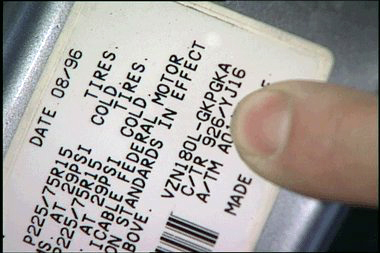
2. Mix Color - Mixing paint based on a paint formula with percentages of each ingredient that is needed to match an OEM color. Anywhere from a touch-up bottle (2 ounces) to a gallon can be mixed, depending on the size of the job.
3. Solvent Wash - A solvent based cleaning material used to remove contamination from surfaces prior to refinishing. A rag dampened with cleaning solution is wiped across an area to be refinished, followed by a dry rag to assist in the evaporation process.
4. Feather Edge - A sanding process of tapering a broken paint edge to a smooth finish. Feather edging is sometimes completed by the body repair technician prior to entering the refinish department.
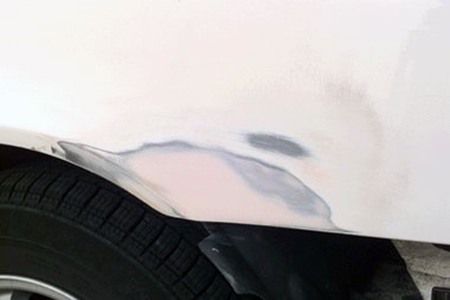
Body repair before featheredge
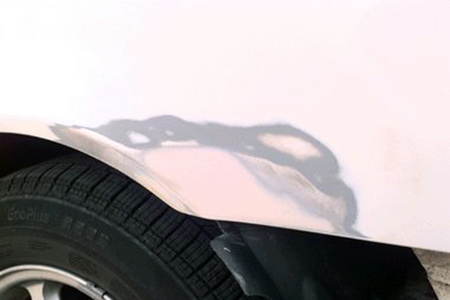
Body repair after featheredge
5. Dust and Water Removal with Air - Using an air blow gun to blow dust and dirt off the vehicle and its parts. It has a trigger that can be pressed to release a strong stream or blast of air. A blow gun is used to dry panels after wet sanding and remove debris along trim pieces and other enclosed areas.
6. Mask to Prime/Paint and Cover Remainder of Vehicle - Process of applying tape and paper to a vehicle to prevent paint from being applied where it is not wanted. To avoid overspray, the remainder of the vehicle is covered with a vehicle cover, plastic, paper or a liquid mask that is water-soluble.
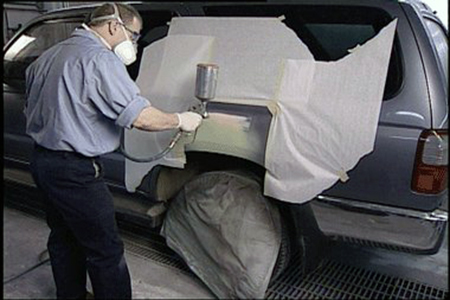
7. Tack Wipe - Wiping surfaces to be refinished with a tack cloth, which is sticky and used to remove dust and other fine particles.
8. Mixing Primer/Paint - Involves blending the paint with hardeners, activators, thinners, reducers and other additives to the correct thickness or viscosity. Coating manufacturers supply mixing sticks displayed with their systems different mixing ratios. These mixing sticks save a lot of time by taking the chemistry out of painting.
9. Mix and Apply Etch Primer - A primer which contains an acid for chemically treating metal for corrosion resistance. Etch primer also promotes adhesion for the primer filler.
10. Mix and Apply Primer Filler - A primer used to fill pitted or rough surfaces and later smoothed by sanding after the primer has cured. A non-corrosion inhibiting primer/filler should not be used directly over bare metal structural or cosmetic parts.
11. Mix and Apply Epoxy Primer - A two-part primer that has the capabilities of an etching and filling primer. To initiate the chemical reaction between the primer and the catalyst, some epoxy primers need to stand a predetermined amount of time before application. Epoxy primers are especially effective in weld joint areas, areas that won't be top coated and enclosed areas such as the box section of a frame rail.
Note: Epoxy primer is an etch and fill primer in one. Its use, replaces the two step process required if self-etch and filler primer are applied separately.
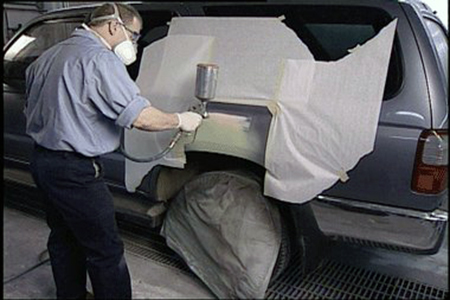
12. Apply Guide Coat (if needed) - A reference coat of a different color often applied to a primer filler. It is sanded off to visually determine if the panel is straight and free of imperfections. Aerosol spray and carbon based powders are just a couple of the products used as a guide coat.
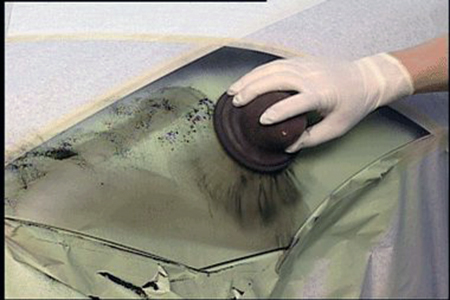
13. Block Sand - A back and forth scrubbing action with the sandpaper mounted on a rubber blocking tool. Block sanding is often used on flat surfaces helping level the surface or make it flat. Block sanding can be done wet or dry.
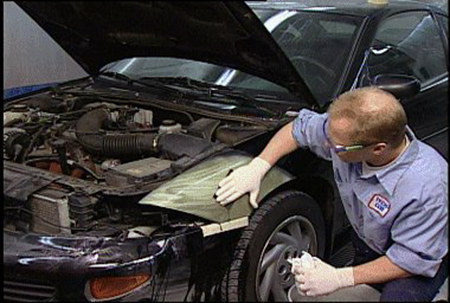
Hand blocking with wet sandpaper and foam block
Option 1: Wet Sand - Using sandpaper that can be used with water for flushing away sanding debris that would otherwise clog fine grits. Wet sanding is for the adhesion of a top-coat. Occasionally coarse dry sanding is done first to remove major surface imperfections, followed by wet sanding for final smoothing.
Option 2: Dry Sand - A term describing sanding done with coarser non-waterproof sandpaper, without using water. Dry sanding is for the adhesion of a top coat and also done to remove material quickly.
14. Scuff Pad Panel - Using a tough synthetic pad to clean and lightly scratch the surface of paints so the new paint will stick. This procedure is usually performed when blending within and into a panel. Scuffing allows the clear to adhere to the existing finish. (A coarser scuff pad is sometimes used to scuff around a repair area before priming. This allows the primer to adhere to the existing finish.)
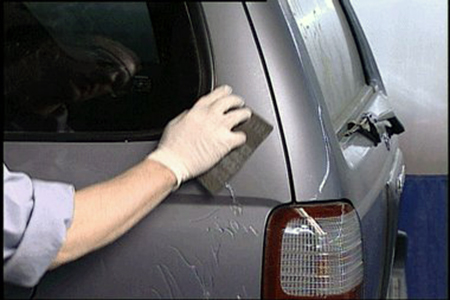
15. Dust or Water Removal with Air - Using an air blow gun to blow dust and dirt off the vehicle and its parts. It has a trigger that can be pressed to release a strong stream or blast of air. A blow gun is used to dry panels after wet sanding and remove debris along trim pieces and other enclosed areas.
16. Mask to Prime/Paint and Cover Remainder of Vehicle - Process of applying tape and paper to a vehicle to prevent paint from being applied where it is not wanted. To avoid overspray, the remainder of the vehicle is covered with a vehicle cover, plastic, paper or a liquid mask that is water-soluble.
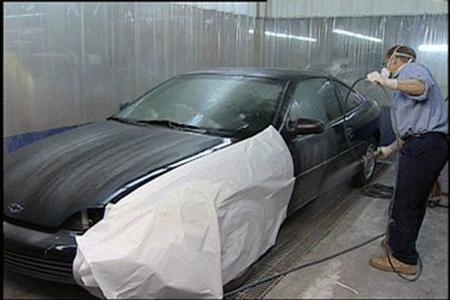
Application of liquid mask, with masking paper protecting repair area
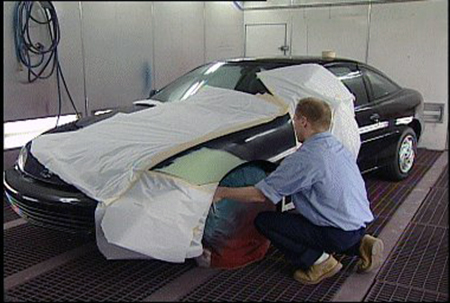
The masking paper is then pulled back over the liquid mask
17. Final Solvent Wash - A solvent based cleaning material used to remove contamination from surfaces prior to refinishing. A rag dampened with cleaning solution is wiped across an area to be refinished, followed by a dry rag to assist in the evaporation process.
18. Tack Wipe - Wiping surfaces to be refinished with a tack cloth, which is sticky and used to remove dust and other fine particles.
19. Mix and Apply Basecoat - A highly pigmented color which requires a coating of clear for protection, durability and gloss. Basecoat is used in two-stage and three-stage paint procedures. Most basecoats dry in 5 minutes and can be sanded and recoated if imperfections appear.
20. Mix and Apply Midcoat - The additional coat applied after the basecoat and before the clearcoat in a three-stage paint procedure. The midcoat is almost always a pearl color.
21. Mix and Apply Single-Stage Color - A one-step paint procedure of applying color, protection and durability in one application. No clear is used.
22. Mix and Apply Clearcoat - A paint containing no pigment or only transparent pigments. Clearcoat is used in two-stage and three-stage paint procedures for durability, gloss and the proper protection of metallic and solid colors.